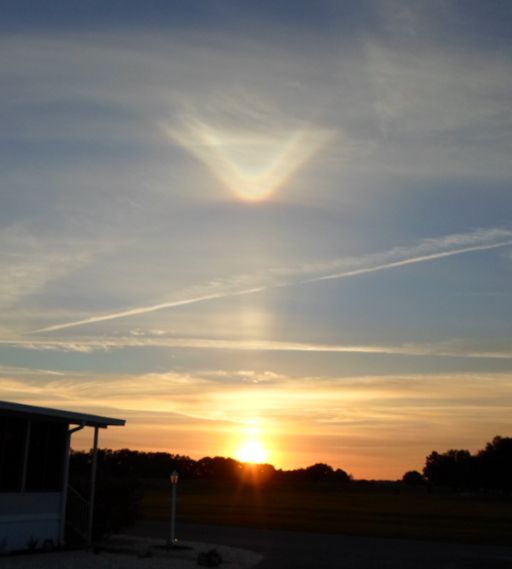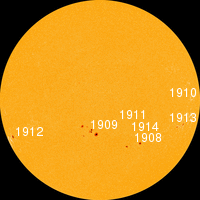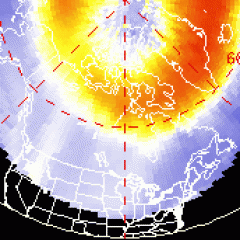~ Space Weather Update~MOSTLY QUIET~ RARE V-SHAPED SUN HALO [1]
MOSTLY QUIET: With no sunspots actively flaring, the Earthside of the sun is quiet. However, two sunspots (AR1908 and AR1909) have 'beta-gamma' magnetic fields that harbor energy for moderately strong eruptions. NOAA forecasters estimate a 25% chance of M-class [2] solar flares on Dec. 3rd. Solar flare alerts: text [3], voice [4]
RARE V-SHAPED SUN HALO: At the end of Thanksgiving Day when the sun was setting over Sumterville, Florida, Paula Phillips took a break from her meal, stepped outside and saw something odd--a pair of luminous 'Vs' in the deepening twilight:
"I've never seen anything like this before," says Phillips. "I photographed the phenomenon with a simple small Samsung camera."
They're sun halos, caused by sunlight shining through ice crystals. Atmospheric optics expert Les Cowley explains:
"These two ‘V’ shaped halos, one rare and one common, change shape [6] dramatically as the sun climbs," he says. "Near sunrise or sunset is the only time to catch them like this. The lower ‘V’ is an upper tangent arc [7] from horizontal hexagonal prisms of ice. The upper one is a rare sunvex Parry arc [8] from similar crystals that - strangely – are fixed so that two prism faces are always horizontal. In the full-sized image [5], we also see just a trace of a 22o halo [9] and stretching upwards from the sun a sun pillar [10]."
"I find it odd that I saw this in Florida!" continues Phillips. Yet Florida has ice crystal, too. The atmosphere 5 to 10 km above the Sunshine State is always cold enough for water to freeze.
"Florida and other warm places get plenty of halos--some of them exceedingly rare [11]," says Cowley. "Look for them everywhere, winter and summer."

Solar wind
speed: 383.2 km/sec
density: 5.3 protons/cm3
explanation [12] | more data [13]
Updated: Today at 2225 UT
X-ray Solar Flares
6-hr max: B9 2107 UT Dec03
24-hr: C1 1528 UT Dec03
explanation [14] | more data [15]
Updated: Today at: 2200 UT
![]()
Daily Sun: 03 Dec 13
Sunspots AR1908 and AR1909 have 'beta-gamma' magnetic fields that harbor energy for M-class [2] solar flares. Credit: SDO/HMI
![]()
Sunspot number: 124
What is the sunspot number? [17]
Updated 03 Dec 2013
Spotless Days
Current Stretch: 0 days
2013 total: 0 days (0%)
2012 total: 0 days (0%)
2011 total: 2 days (<1%)
2010 total: 51 days (14%)
2009 total: 260 days (71%)
Since 2004: 821 days
Typical Solar Min: 486 days
Update 03 Dec 2013
The Radio Sun
10.7 cm flux: 134 sfu
explanation [18] | more data [19]
Updated 03 Dec 2013
![]()
Current Auroral Oval:
Switch to: Europe, USA, New Zealand, Antarctica
Credit: NOAA/POES
![]()
Planetary K-index
Now: Kp= 2 quiet
24-hr max: Kp= 3 quiet
explanation [21] | more data [22]
Interplanetary Mag. Field
Btotal: 4.9 nT
Bz: 1.3 nT south
explanation [23] | more data [24]
Updated: Today at 2226 UT
![]()
Coronal Holes: 03 Dec 13
A stream of solar wind flowing from the indicated coronal hole should reach Earth on Dec. 7-8. Credit: SDO/AIA.



